Do you have a question about the Gardena 4000/5 and is the answer not in the manual?
Describes the primary purpose and application of the pressure tank unit.
Lists acceptable and unacceptable liquids for pumping with the unit.
Specifies the maximum permissible temperature for the liquid being pumped.
Details safety requirements for operating the pump near water bodies.
Outlines specifications for power cables and extension cords.
Electrical connection requirements specific to Austria.
Electrical connection requirements specific to Switzerland.
Guidance on selecting a suitable location for the pump.
Instructions for performing a pre-operation visual inspection.
Guidance on verifying the mains voltage supply.
Ensures proper sealing of filter and backflow valve lids during operation.
Important safety warning about handling the pump by its power cable.
Instruction to disconnect power before maintenance.
Advice to prevent pump damage from operation without water.
Information on how abrasive substances affect pump performance.
Clarifies that the unit is not designed for industrial or continuous use.
Specifies the required minimum flow rate for proper operation.
Details the maximum allowable internal pressure on the delivery side.
Details the suction unit accessory and its article number.
Lists available suction hoses with their specifications.
Describes the suction filter and backflow preventer accessory.
Information on the suction hose designed for bore holes.
Lists available quick thread couplings for hose connections.
Instructions for using the fixing plate for stable pump mounting.
Recommends specific hoses to reduce noise during fixed installation.
Importance of installing shut-off valves for maintenance and cleaning.
Instructions for connecting hoses to the delivery side of the pump.
Guidance on hose size for achieving best delivery performance.
Recommendation for connecting to pipes or bore holes.
Advice for securing suction hoses at greater heights.
Steps for positioning and filling the pump before initial use.
Specifies the required placement and clearance for the pump.
Steps for starting the pump for the first time.
Detailed procedure for the initial operation of the pump.
Describes the pump's startup sequence and automatic shut-off.
Explains the function and settings of the manometric switch.
Lists common fault conditions and their probable causes.
Defines the pump's process for restoring normal operation after a fault.
Describes the system's behavior when attempting automatic restart.
Explains how to reset and restart the pump by replugging.
Indicates the pump is connected to mains power.
Shows the pump is running and has reached maximum pressure.
Signals a low flow rate on the delivery side.
Indicates a low flow rate on the inlet side.
Shows low water amount during restart or priming.
Alerts to low water amount during normal operation.
Indicates automatic self-priming is inactive and no water is supplied.
Warns of a leak in the pipe system.
Instructions for environmentally friendly disposal of the product.
Diagnoses and remedies for reduced pump performance.
Identifies causes and solutions for the pump failing to deliver water.
Troubleshooting frequent pump cycling with high flow rates.
Addresses issues with the pump failing to start or stopping unexpectedly.
Explains causes for pump cycling without water usage.
Troubleshooting frequent pump on/off cycles after water draw-off.
Solutions for situations where the pump fails to initiate operation.
Describes the primary purpose and application of the pressure tank unit.
Lists acceptable and unacceptable liquids for pumping with the unit.
Specifies the maximum permissible temperature for the liquid being pumped.
Details safety requirements for operating the pump near water bodies.
Outlines specifications for power cables and extension cords.
Electrical connection requirements specific to Austria.
Electrical connection requirements specific to Switzerland.
Guidance on selecting a suitable location for the pump.
Instructions for performing a pre-operation visual inspection.
Guidance on verifying the mains voltage supply.
Ensures proper sealing of filter and backflow valve lids during operation.
Important safety warning about handling the pump by its power cable.
Instruction to disconnect power before maintenance.
Advice to prevent pump damage from operation without water.
Information on how abrasive substances affect pump performance.
Clarifies that the unit is not designed for industrial or continuous use.
Specifies the required minimum flow rate for proper operation.
Details the maximum allowable internal pressure on the delivery side.
Details the suction unit accessory and its article number.
Lists available suction hoses with their specifications.
Describes the suction filter and backflow preventer accessory.
Information on the suction hose designed for bore holes.
Lists available quick thread couplings for hose connections.
Instructions for using the fixing plate for stable pump mounting.
Recommends specific hoses to reduce noise during fixed installation.
Importance of installing shut-off valves for maintenance and cleaning.
Instructions for connecting hoses to the delivery side of the pump.
Guidance on hose size for achieving best delivery performance.
Recommendation for connecting to pipes or bore holes.
Advice for securing suction hoses at greater heights.
Steps for positioning and filling the pump before initial use.
Specifies the required placement and clearance for the pump.
Steps for starting the pump for the first time.
Detailed procedure for the initial operation of the pump.
Describes the pump's startup sequence and automatic shut-off.
Explains the function and settings of the manometric switch.
Lists common fault conditions and their probable causes.
Defines the pump's process for restoring normal operation after a fault.
Describes the system's behavior when attempting automatic restart.
Explains how to reset and restart the pump by replugging.
Indicates the pump is connected to mains power.
Shows the pump is running and has reached maximum pressure.
Signals a low flow rate on the delivery side.
Indicates a low flow rate on the inlet side.
Shows low water amount during restart or priming.
Alerts to low water amount during normal operation.
Indicates automatic self-priming is inactive and no water is supplied.
Warns of a leak in the pipe system.
Instructions for environmentally friendly disposal of the product.
Diagnoses and remedies for reduced pump performance.
Identifies causes and solutions for the pump failing to deliver water.
Troubleshooting frequent pump cycling with high flow rates.
Addresses issues with the pump failing to start or stopping unexpectedly.
Explains causes for pump cycling without water usage.
Troubleshooting frequent pump on/off cycles after water draw-off.
Solutions for situations where the pump fails to initiate operation.
| Power | 1100 W |
|---|---|
| Max delivery capacity | 4000 l/h |
| Max self-priming suction | 8 m |
| Cable length | 1.5 m |
| Pump impeller | Jet |
| Protection class | IPX4 |
| Voltage | 230 V |
| Frequency | 50 Hz |
| Connection thread | 33.3 mm (G 1") |
| Inlet/Outlet Diameter | G1 (33.3 mm) |
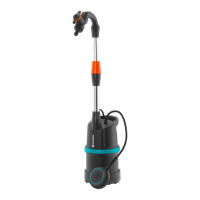
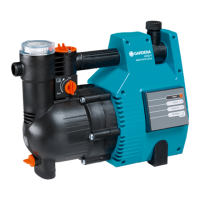
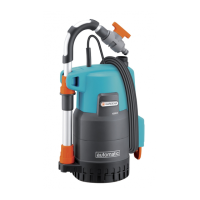



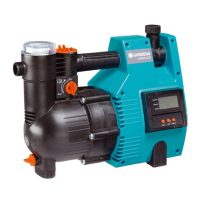

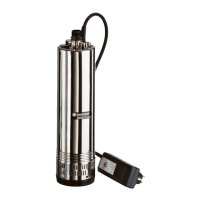
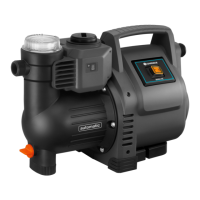
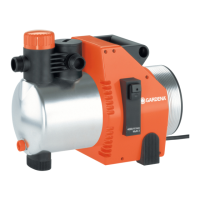
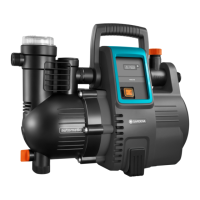
